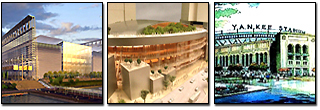When Mayor Michael Bloomberg argues that the city should build a new stadium for the Jets football team, he often points to other cities like Atlanta or St. Louis. These cities already have domed stadiums like the one Bloomberg wants to build and have played host to the Super Bowl, the 1996 Olympics, monster truck rallies, and even a visit from the Pope.
“New Yorkers will be the big winners if this project becomes reality,” the mayor said.
But Mayor Bloomberg does not mention that these stadiums have not turned out to be as great a deal as officials initially predicted.
In Atlanta, an expanded center was met with a drop in attendance. In St. Louis, surrounding hotels are still empty. And he never mentions the Seattle King Dome - once the largest dome in the world - which suffered an even worse fate. In 2000, the aging structure was blown up even though the county still owed $125 million on it.
Closer to home, officials in New Jersey recently agreed to a new $750 million stadium for the New York Giants football team, even though the state will have to pay $30 million for surrounding roads and will still owe $124 million in debt on the old stadium. In Newark, the housing authority diverted $3.9 million in federal funds meant for low-income residents to a new arena designed to keep the Nets basketball team from moving to Brooklyn.
In the last 25 years, the nation has experienced a stadium and arena boom.
More than 50 stadiums or arenas have been built in the U.S. and Canada since 1990. And 12 baseball stadiums, nine football stadiums, and eight basketball arenas are being promised for the future, according to League of Fans, which was founded by Ralph Nader.
In New York City, six sports teams - the Jets, the Yankees, the Mets, the Knicks, the Rangers, and the (recently purchased) Brooklyn Nets - all want expensive new places to play.
While fans may argue that teams play a significant role in the life of a city, most economists agree that stadiums and arenas are bad public investments.
"By having a sports team or a new stadium or arena, you don't increase the level of per capita income, and you don't increase the level of employment," said Andrew Zimbalist, a professor of sports and economics. "There's no direct economic development of communities."
Some critics, such as those who run Web sites like www.fieldofschemes.com, see all of these sports complexes as boondoggles.
They point toward examples like PNC Park, a $262 million baseball stadium for the Pittsburgh Pirates, which was built mostly with taxpayer money, even after voters rejected it.
“I fundamentally don’t believe that the public ought to be investing in ballparks,” Pittsburgh Mayor Tom Murphy said at a recent forum (read the full transcript). “That said, we have built a new football stadium, a new baseball park and a convention center, and we spent $1 billion. That’s reality; that’s the marketplace.”
But others argue there is a good way to build stadiums.
SBC Park, a baseball stadium in San Francisco, for example, was paid for almost entirely by the Giants. It is hailed as the first privately funded ballpark for Major League Baseball since Dodgers Stadium was built in 1962.
Not all stadiums are equal.
Football stadiums seat 75,000 people and if they have a roof can be used for other large indoor events as well. These facilities cost the most. (Click hereto see how the West Side stadium compares to other similar domes.)
Baseball stadiums are smaller, seating 35,000 to 50,000 people, and in addition to games can only be used for open-air events. (Click hereto see how the proposed Yankee stadium compares to other ballparks.)
Indoor arenas are used for basketball and hockey, seat around 20,000 people, and cost the least. (Click hereto see how the proposed Brooklyn Nets arena compares to other arenas.)
But when comparing New York’s proposed stadiums and arenas to others across the country, some things are clear:
- New York’s sports venues would be by far the most expensive ever built
- They depend on large subsidies by the taxpaying public
- The city may be repeating mistakes that have been made elsewhere in the country.
See how New York’s stadiums and arenas match up (click below to get to the three grids):
* The proposed West Side stadium, and existing domed football stadiums.
* The proposed Yankee stadium, and existing ballparks.
* The proposed Brooklyn Nets arena, and existing arenas.
* The mayors of Pittsburgh, Kansas City and San Francisco explain how they built their stadiums.
Related Articles:
* New York Sports Economy
* Stadium Fever
* The 2012 Olympics and New York
* The West Side Stadium
* Bringing the Jets Home Dreaming of a Jets Stadium in Queens
Related Links:
* NewYorkGames.org
* New York Association of Better Choices
* Hell's Kitchen Online
* No Land Grab - Anti-Nets Arena Web Site
* Develop, Don't Destroy Brooklyn
* Field of Schemes
* League of Fans
* Ball Parks
* Stadiums of NFL





